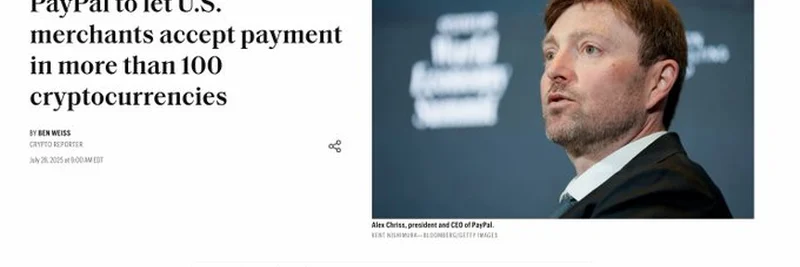Hey there, crypto enthusiasts! If you’ve been keeping an eye on the blockchain world, you’ve probably heard the buzz about PayPal’s latest move. On July 28, 2025, the fintech giant dropped a bombshell by letting US merchants accept payments in over 100 cryptocurrencies. Yes, you read that right—over 100! This includes heavy hitters like Bitcoin and Ethereum, as well as quirky meme coins like Trump’s memecoin and even the wild Fartcoin. Let’s dive into what this means, straight from the tweet by MartyParty, and unpack the excitement (and skepticism) surrounding this development.
The Big Announcement
PayPal’s new payment option, launched on a Monday morning, is a game-changer for smaller US businesses. Any merchant using PayPal’s online payments platform can now opt in to accept these digital assets. The Fortune Crypto article accompanying the tweet highlights how this move allows shoppers from places like Guatemala to buy gifts from merchants in Oklahoma City using crypto. It’s a global bridge built on blockchain technology!
The catch? PayPal isn’t doing this for free. They’re charging a promotional fee of 0.99% on transactions for the first year, which will jump to 1.5% afterward. According to Frank Keller, an executive vice president at PayPal, this is still lower than the 1.57% average credit card fees businesses paid in 2024. It’s a step toward savings, but is it the best option? Let’s explore.
The Spin vs. The Reality
MartyParty’s tweet cuts through the hype with a sharp take. On one hand, this is a win for crypto adoption. More merchants and customers will get comfortable using digital currencies as a payment method, which could pave the way for broader use of blockchain-based payment rails. PayPal’s system lets users connect their crypto wallets to a checkout page, where the crypto is sold (via exchanges like Coinbase or Uniswap) and converted into PayPal’s stablecoin, PYUSD, before becoming US dollars for the merchant.
But here’s the kicker: you don’t need PayPal for this. MartyParty points out that merchants can accept crypto directly using a simple crypto wallet, cutting out the middleman entirely. This peer-to-peer approach eliminates fees altogether, aligning with the core promise of blockchain—no intermediaries, just you and the merchant. PayPal’s 1.5% fee, while lower than credit card rates, adds a layer that some see as unnecessary.
Why Native Crypto Might Be Better
So, why not skip PayPal and go straight to native crypto? Well, it’s not all smooth sailing. Bitcoin and Ethereum, the big names in crypto, can be slow for retail transactions. Bitcoin takes about 10 minutes per transaction, while Ethereum clocks in at 13-15 seconds per block. That’s fine for big moves but tedious for quick purchases. PayPal’s solution aims to smooth this out with a centralized approach, similar to Ethereum’s Layer 2 solutions.
However, modern high-speed Layer 1 blockchains (like Ripple or Stellar, which handle thousands of transactions per second) are designed to tackle this without middlemen. MartyParty argues that accepting native crypto directly could save merchants the full 3% credit card fees, aiming for that elusive 0% fee goal. It’s a bold vision, and one that could reshape how we think about payments.
Meme Coins and the Fun Side
What’s extra exciting for us at Meme Insider is the inclusion of meme coins! Tokens like Trump’s memecoin and Fartcoin bring a playful vibe to the crypto space. These assets, often driven by community hype, are now part of PayPal’s ecosystem. It’s a nod to the cultural impact of memes in blockchain, and we’ll be keeping a close eye on how they perform as payment options.
The Takeaway
This PayPal move is a step forward for crypto awareness among merchants. It’s a signal that digital assets are the future of payments, as Keller hinted with his “on-chain” worldview. But MartyParty’s skepticism resonates—why add a middleman when blockchain can connect buyers and sellers directly? For now, it’s a compromise: lower fees than credit cards, but not the fee-free utopia crypto promises.
If you’re a merchant, weigh your options. Test PayPal’s system, but also consider setting up a crypto wallet for direct payments. And for meme coin lovers, this could be your chance to spend those quirky tokens! What do you think—will this drive crypto adoption or just create another layer of complexity? Drop your thoughts in the comments, and stay tuned to Meme Insider for more blockchain updates!


